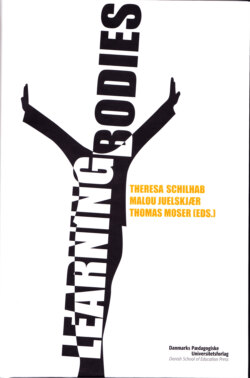Читать книгу Learning Bodies - Группа авторов - Страница 27
На сайте Литреса книга снята с продажи.
Introduction
ОглавлениеThere is a growing interest in the human body in areas like cognitive science, social science, psychology and human development (e.g. Lakoff & Johnson 1999; Leder 1990, 1992; Sheet-Johnstone 1992; Shilling 1993; Stam 1998; Varela, Thompson & Rosch 1991).
This trend towards the body can be related to some of the following areas or research fields:
• Phenomenological thinking, which puts focus on the lived body as a central source for experience and perception, is receiving growing attention in different research areas (such as psychology, psychiatry, psychosomatic medicine, anthropology, philosophy) and is even finding its place in the “hard core” science of neuro-research.
• In social science there is a growing interest in body politics, a notion which takes into account the role of the body in impression management and social diversity.
• In feminism,as an important focus area of social science, researchers are interested in the sexed and gendered bodies, that is, in the manifestation of gender difference which can be traced back to specific bodily manifestations in the interaction between women and men.
• In therapeutic practice, body experience is established as the attentive focus in the therapeutic process, where this experiential awareness is seen as the source of reflections on the individual’s mental status quo and as the basis for developmental processes in therapy.
• In Buddhist practice,which is of growing interest in western society, the focus is on bodily experiences as the basis for meditation.
• Finally, a reaction to some fundaments of social constructionism can be noted in the literature (e.g. Searle 1992; Stam 1998, 2001, 2002); voices that call for an experiential and embodied basis of being. Sampson (1998), for example, changed his exclusively social constructionist-oriented standpoint in the following way:
Social constructionism includes history, culture and community, yet for the most part shares with the dominant tradition an exclusion of the body, other than the same ocularcentric object-body. It engages in discourses about this body and how it is constructed in history, culture and community, but does not engage in embodied discourses. What is needed, I argue, is a genuinely inclusive discourse that not only addresses the inherently historical, cultural and communal character of human endeavour, but its inherently embodied character as well. (Sampson 1998, p. 35).
Also in the field of learning, the body is receiving growing recognition as a central domain for the understanding of what happens in these processes of change and development. Beside other factors, this new orientation can be connected to a re-emerging interest in the experiential dimension of learning (Dewey 1963) and in general to a change in the orientation of what is defined as and understood by learning and education (Bruner 1996; Lave & Wenger 1991). But the search for literature on body and learning is not very successful if the focus is turned away from areas like motor learning and skill development (e.g. Schmidt 1991). With this lack of literature in mind, it seems worthwhile to concentrate our attention on the bodily foundations for the process of learning and developing.
Body-anchored experiencing and learning do not only relate to learning in the field of sport and movement, an obvious area for our investigation; furthermore, body-anchored experiencing and learning can be defined as an experiential person-environment interplay towards change, which has its point of departure in the sensuous basis of bodily perceptions.
The intention of this chapter is to unfold and present the experiential or first-person perspective as a source of the individual’s deeper understanding of his/her interplay with a specific context and environment. This perspective will be connected to the concept of the lived body, which can be seen as the basis for the understanding of experience and perception. The ideas presented take their point of departure in a concept of situated action as a function of person and environment. The first-person perspective will be assessed as an important prerequisite for sensual and embodied experiencing and further on for body-anchored learning.
